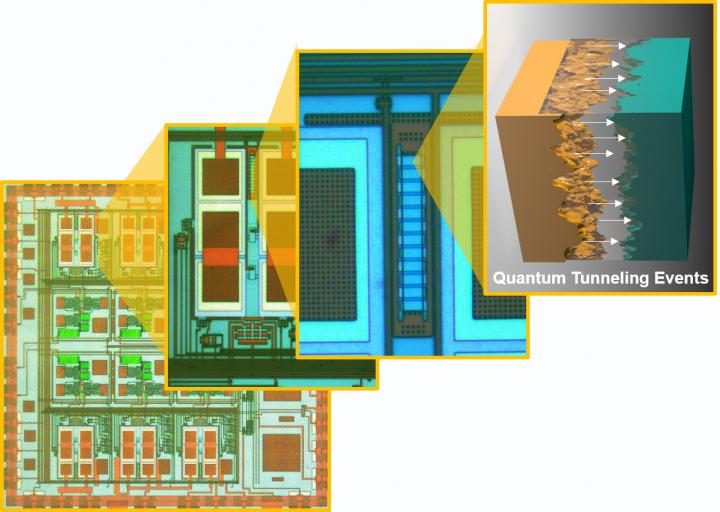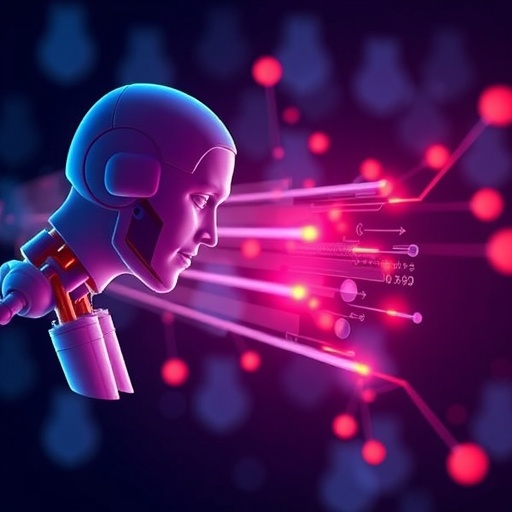With just a 50-million-electron jumpstart, sensors can power themselves for more than a year

Credit: Chakrabartty Lab, McKelvey School of Engineering, Washington University in St. Louis
Shantanu Chakrabartty’s laboratory has been working to create sensors that can run on the least amount of energy. His lab has been so successful at building smaller and more efficient sensors, that they’ve run into a roadblock in the form of a fundamental law of physics.
Sometimes, however, when you hit what appears to be an impenetrable roadblock, you just have to turn to quantum physics and tunnel through it. That’s what Chakrabartty and other researchers at the McKelvey School of Engineering at Washington University in St. Louis did.
The development of these self-powered quantum sensors from the lab of Chakrabartty, the Clifford W. Murphy Professor in the Preston M. Green Department of Systems & Electrical Engineering, was published online Oct. 28 in the journal Nature Communications.
The roadblock that inspired this research is the threshold effect.
“Imagine there is an apple hanging from a tree,” Chakrabartty said. “You can shake the tree a little bit, but the apple doesn’t fall. You have to give it enough of a tug to shake the apple loose.” That tug is akin to a threshold energy. “It’s the minimal amount of energy needed to move an electron over a barrier.” If you cannot move the electron over the barrier, you cannot create current.
But naturally occurring quantum mechanical phenomenon move electrons across barriers all the time. The research team took advantage of this to build a self-powered device that, with a small initial energy input, can run on its own for more than a year.
This is how it’s built:
The device is simple and inexpensive to build. All it requires is four capacitors and two transistors.
From these six parts, Chakrabartty’s team built two dynamical systems, each with two capacitors and a transistor. The capacitors hold a small initial charge, about 50 million electrons each.
They added a transducer to one of the systems and coupled it to the property they were measuring. In one application, the team measured ambient micromotion using a piezoelectric accelerometer, a type of transducer that turns mechanical energy (such as movement of molecules in the air) into electric signals.
This is what you need to know:
Quantum physics. At least some of the more unusual properties of subatomic particles, particularly tunneling.
Imagine a hill, Chakrabartty said. “If you want to get to the other side, you have to physically climb the hill. Quantum tunneling is more like going through the hill.”
The beauty of this, he said, is that when the hill is a certain shape, you get very unique, dynamical properties that could last for years.
In this case, the “hill” is actually a barrier called a Fowler-Nordheim tunneling barrier. It’s positioned between the plate of a capacitor and a semiconductor material; it’s less than 100 atoms thick.
By building the barrier in a certain way, Chakrabartty said, “you can control the flow of electrons. You can make it reasonably slow, down to one electron every minute and still keep it reliable.” At that rate, the dynamical system runs like a timekeeping device — without any batteries — for more than a year.
This is how it works:
To measure ambient motion, a tiny piezoelectric accelerometer was connected to the sensor. Researchers mechanically shook the accelerometer; its motion was then transformed into an electric signal. This signal changed the shape of the barrier, which, thanks to the rules of quantum physics, changed the rate at which the electrons tunneled through the barrier.
To make sense of what happened, the process needs to be read as a sort of backward Rube Goldberg machine.
The probability that a certain number of electrons will tunnel through the barrier is a function of the barrier’s size. The size of the barrier is determined by the energy produced by the piezoelectric transducer, which in turn, is determined by the magnitude of the acceleration — how much it shook.
By measuring the sensor capacitors’ voltage and counting how many electrons were missing, Darshit Mehta, a PhD student in Chakrabartty’s lab and the lead author on the paper, was able to determine the total acceleration energy.
Of course, to be put to practical use, these extremely sensitive devices would likely be moving around — on a truck, keeping track of the ambient temperature of in cold-chain management of vaccines, for example. Or in your blood, monitoring glucose.
That’s why each device is actually two systems, a sensing system and a reference system. At the outset, the two are nearly identical, only the sensing system was connected to a transducer while the reference system was not.
Both systems were engineered so that electrons tunneled at the same rate, destined to deplete their capacitors identically had there not been any outside forces at play.
Because the sensing system was affected by signals it received from the transducer, its electrons tunneled at different times than the reference system. After the experiments, the research team read the voltage in both the sensing and reference system capacitors. They used the difference in the two voltages to find the true measurements from the transducer.
For some applications, this final result is sufficient. The next step for Chakrabartty’s team is to overcome the computational challenge of more precisely recreating what happened in the past — how exactly were the electrons affected? When did an electron tunnel through the barrier? How long did it take to tunnel?
One of the goals of Mehta’s PhD thesis is to use multiple devices to reconstruct the past. “The information is all stored on the device, we just have to come up with clever signal processing to solve this,” Chakrabartty said.
Ultimately, these sensors hold promise for everything from continuous monitoring of glucose levels inside the human body, to possibly recording neural activity without using batteries.
“Right now, the platform is generic,” Chakrabartty said. “It just depends on what you couple to the device. As long as you have a transducer that can generate an electrical signal, it can self-power our sensor-data-logger.”
###
Media Contact
Brandie Jefferson
[email protected]
Original Source
https:/
Related Journal Article
http://dx.




